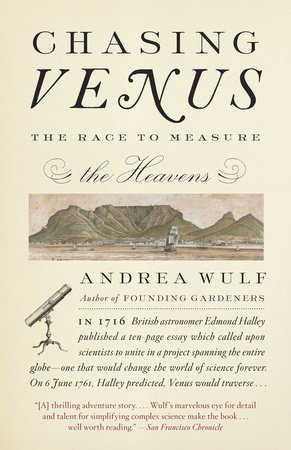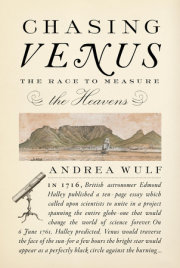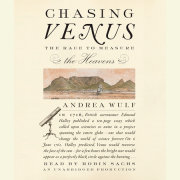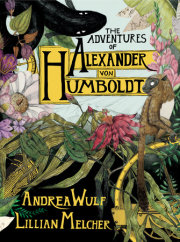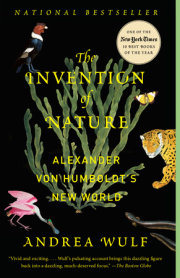Prologue
The Gauntlet
The Ancient Babylonians called her Ishtar, to the Greeks she was Aphrodite and to the Romans Venus – goddess of love, fertility, and beauty. She is the brightest star in the night sky and visible even on a clear day. Some saw her as the harbinger of morning and evening, of new seasons or portentous times. She reigns as the ‘Morning Star’ or the ‘Bringer of Light’ for 260 days, and then disappears to rise again as the ‘Evening Star’ and the ‘Bringer of Dawn’.
Venus has inspired people for centuries, but in the 1760s astronomers believed that the planet held the answer to one of the biggest questions in science – she was the key to understanding the size of the solar system.
In 1716 British astronomer Edmond Halley published a ten-page essay which called upon scientists to unite in a project spanning the entire globe – one that would change the world of science forever. On 6 June 1761, Halley predicted, Venus would traverse the face of the sun – for a few hours the bright star would appear as a perfectly black circle. He believed that measuring the exact time and duration of this rare celestial encounter would provide the data that astronomers needed in order to calculate the distance between the earth and the sun.
The only problem was that the so-called transit of Venus is one of the rarest predictable astronomical events. Transits always arrive in pairs – eight years apart – but with an interval of more than a century before they are then seen again. Only once before, Halley said, in 1639, had an astronomer called Jeremiah Horrocks observed the event. The next pair would occur in 1761 and 1769 – and then again in 1874 and 1882.
Halley was sixty years old when he wrote his essay and knew that he would not live to see the transit (unless he reached the age of 104), but he wanted to ensure that the next generation would be fully prepared. Writing in the journal of the Royal Society, the most important scientific institution in Britain, Halley explained exactly why the event was so important, what these ‘young Astronomers’ had to do, and where they should view it. By choosing to write in Latin, the international language of science, he hoped to increase the chances of astronomers from across Europe acting upon his idea. The more people he reached, the greater the chance of success. It was essential, Halley explained, that several people at different locations across the globe should measure the rare heavenly rendezvous at the same time. It was not enough to see Venus’s march from Europe alone; astronomers would have to travel to remote locations in both the northern and southern hemispheres to be as far apart as possible. And only if they combined these results – the northern viewings being the counterpart to the southern observations – could they achieve what had hitherto been almost unimaginable: a precise mathematical understanding of the dimensions of the solar system, the holy grail of astronomy.
Halley’s request would be answered when hundreds of astronomers joined in the transit project. They came together in the spirit of the Enlightenment. The race to observe and measure the transit of Venus was a pivotal moment in a new era – one in which man tried to understand nature through the application of reason.
This was a century in which science was worshipped, and myth at last conquered by rational thought. Man began to order the world according to these new principles. The Frenchman Denis Diderot, for example, was amassing all available knowledge for his monumental
Encyclopédie. The Swedish botanist Carl Linnaeus classified plants according to their sexual organs, and in 1751 Samuel Johnson imposed order upon language when he had compiled the first English dictionary. As new inventions such as microscopes and telescopes opened up previously unknown worlds, scientists were able to zoom in on the minutiae of life and gaze into infinity. Robert Hooke had peered through his microscope to produce detailed engravings of magnified seeds, fleas and worms – he was the first to call the basic unit of biological life a ‘cell’. In the North American colonies Benjamin Franklin was experimenting with electricity and lightning rods, controlling what until then had been regarded as manifestations of divine fury. Slowly the workings of nature became clearer. Comets were no longer viewed as portents of God’s wrath but, as Halley had shown, predictable celestial occurrences. In 1755 the German philosopher Immanuel Kant suggested that the universe was much larger than his contemporaries believed and that it consisted of uncountable and gigantic ‘
Welteninseln’ – ‘cosmic islands’, or galaxies.
Humankind believed it was marching along a trajectory of progress. Scientific societies were founded in London, Paris, Stockholm, St Petersburg, and in the North American colonies in Philadelphia, to explore and exchange this new-found knowledge. Observation, enquiry and experimentation were the building blocks of this new understanding of the world. With progress as the leading light of the century, every generation envied the next. Whereas the Renaissance had looked back upon the past as the Golden Age, the Enlightenment looked firmly to the future.
Halley’s idea of using the transit of Venus as a tool to measure the heavens was born out of developments in astronomy over the previous century. Until the early seventeenth century man had observed the sky with his naked eye, but technology was slowly catching up with the reach of his ambitions and theories. Astronomy had changed from a science which mapped stars to one which sought to understand the motion of planetary bodies. In the early sixteenth century Nicolaus Copernicus had proposed the revolutionary idea of the solar system with the sun rather than the earth at the centre, and the other planets moving around it – a model that had been expanded and verified by Galileo Galilei and Johannes Kepler in the early seventeenth century. But it was Isaac Newton’s groundbreaking
Principia, in 1687, which had defined the underlying universal laws of motion and gravity that ruled all and everything. As astronomers gazed at the stars, they were no longer in search of God but of the laws governing the universe.
By the time Halley called upon his fellow astronomers to view the transit of Venus, the universe was regarded as running like a divinely created clockwork according to laws which humankind had only to comprehend and compute. The position and movements of planets were no longer seen as ordained arbitrarily by God but as ordered and predictable, and based on natural laws. But man still lacked the knowledge of the actual size of the solar system – an essential piece of the celestial jigsaw puzzle.
Understanding the dimensions of the heavens had ‘always been a principle object of astronomical inquiry’, the American astronomer and Harvard professor John Winthrop said in the transit decade. Already in the early seventeenth century Kepler had discovered that by knowing how long it took for a planet to orbit the sun, the relative distance between the sun and the planet could be calculated (the longer it took a planet to orbit the sun, the further away it was). From this he had been able to work out the distance between the earth and the sun relative to the other planets – a unit of measurement that became the basis for calculating comparative distances in the universe.† Astronomers knew, for example, that the distance between the earth and Jupiter was five times that of the distance between the earth and the sun. The only problem was that no one had as yet been able to quantify that distance in more specific terms.
Eighteenth-century astronomers had a map of the solar system, but no idea of its true size. Without knowing how far the earth really was from the sun, such a map was all but useless. Venus, so Halley believed, was the key to unlocking this secret. As the brightest star in the sky, Venus became the perfect metaphor for the light of reason that would illuminate this new world and extinguish the last vestiges of the Dark Ages.
Unlike most astronomers whose lives were ruled by the repetitive labour of their nightly observations, Halley had embarked on a far more exciting career – which was probably why he could envisage a global army of swashbuckling astronomers. Not only had he spent one and a half hours in a diving bell submerged almost twenty metres deep in the Thames, he had also undertaken three expeditions to the South Atlantic as the first European to map the southern night sky with a telescope. Halley ‘talks, swears, and drinks brandy like a sea captain’, a colleague said, but he was also one of the most inspired scientists of his age. He had predicted the return of the eponymous Halley’s Comet, produced a map of the southern stars and convinced Isaac Newton to publish his
Principia.
Knowing that he would not be alive to orchestrate the global cooperation to view Venus’s transit – a fact that Halley lamented ‘even on his death-bed’ whilst holding a glass of wine in his hand – all he could do was to place his trust in future generations and hope that they would remember his instructions half a century hence. ‘Indeed I could wish that many observations of this same phenomenon might be taken by different persons at separate places’, he wrote. ‘I recommend it therefore, again and again, to those curious Astronomers who (when I am dead) will have an opportunity of observing these things’.
Halley was asking his future disciples to embark on a project that was bigger and more visionary than any scientific endeavour previously undertaken. The dangerous voyages to remote outposts would take many months, possibly even years. Astronomers would be risking their lives for a celestial event that would last just six hours and be visible only if weather conditions permitted it. The transit would be so short that even the brief appearance of clouds or rain would make accurate observations difficult or even impossible.
In preparation for it, scientists would need to secure funding for the best telescopes and instruments as well as for travel, accommodation and salaries. They would have to convince their respective monarchs and governments to support their individual efforts and would have to coordinate their own observations with those from other countries. Nations locked in battle would have to work together in the name of science for the first time ever. From many dozens of locations, hundreds of astronomers would have to point their telescopes to the sky at exactly the same moment in order to see Venus’s progress across the burning disc of the sun.
And perhaps even more challenging still – though less exhilarating – they must then share their findings. Each observer would have to add his or her observations to the pool of international data. No single result would be of any use without the others. In order to calculate the distance between the sun and the earth, astronomers would have to compare the figures and consolidate the different data into one definitive result. Timings obtained across the world using a disparate range of clocks and telescopes would somehow have to be standardised and made comparable.
The transit of Venus observations were to be the most ambitious scientific project that had ever been planned – an extraordinary undertaking in an era when a letter posted in Philadelphia took two to three months to reach London, and when the journey from London to Newcastle was six days. It took a great leap of the imagination to propose that astronomers should travel thousands of miles into the wildernesses far north and south, laden with instruments weighing more than half a ton.
Their idea of calculating exact distances in space was a bold concept too, considering that clocks were still not accurate enough to measure longitude precisely, and there was as yet no standardised measurement on Earth: an English mile was a different length from a mile in German-speaking countries – which also varied between northern Germany and Austria. A ‘
mil’ in Sweden was more than ten kilometres, in Norway more than eleven, while a French league could be three kilometres but also as much as four and a half. In France alone there were 2,000 different units of measurement – which varied even between neighbouring villages. In light of this, the idea of merging hundreds of observations taken by astronomers across the world to find one common value seemed outrageously ambitious.
The scientists, who were to leave their observatories in the learned centres of Europe to view Venus from remote outposts of the known world, made for strange adventurers too. At first sight they might not have looked like heroic explorers, but as they chased Venus across the globe they did so with extraordinary intrepidity, bravery and ingenuity. On 6 June 1761 and again on 3 June 1769, several hundred astronomers all over the world pointed their telescopes towards the sky to see Venus travel across the sun. They ignored religious, national and economic differences to unite in what was the first global scientific project. This is their story.
Excerpted from
CHASING VENUS by Andrea Wulf. Copyright © 2012 by Andrea Wulf. Excerpted by permission of Alfred A. Knopf, a division of Random House, Inc. All rights reserved. No part of this excerpt may be reproduced or reprinted without permission in writing from the publisher.
Copyright © 2012 by Andrea Wulf. All rights reserved. No part of this excerpt may be reproduced or reprinted without permission in writing from the publisher.

